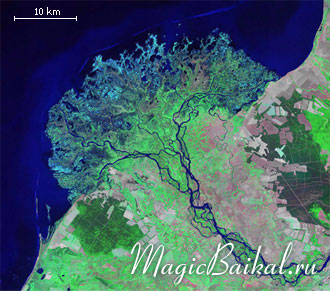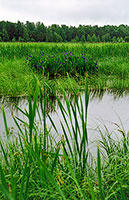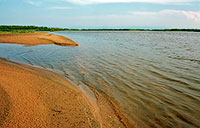The River Selenga and its Delta
 The River Selenga and its Delta
The River Selenga and its DeltaSource for this data set was the Global Land Cover Facility, www.landcover.org.
The river Selenga, Lake Baikal's largest tributary, arises in Mongolia. Its source is at the confluence of the rivers Ider–Gol and Delger–Muren.
There are a few hypotheses about the distant past of the Selenga. According to one of them, deep in the past¬Ý‚Äî even before the formation of the Baikal depression¬Ý‚Äî the Selenga and Angara were one river. Another hypothesis supposes that the Selenga was once the tributary of the Lena.
There is no one opinion as to how the Selenga got its name. One version has it that the word ¬´selenga¬ª came from the Evenk word ¬´sele¬ª¬Ý‚Äî ¬´iron¬ª, but another holds that it came from the Buryat ¬´sel¬ª¬Ý‚Äî ¬´flood¬ª, or ¬´lake¬ª. The argument against the second version is that the name ¬´Selenga¬ª was used in the distant past, when Buryats had still not emerged as a people, while against the first is the fact that the Selenga bears no relation to iron whatsoever.
The length of the Selenga from its source¬Ý‚Äî the junction with the river Ider‚ÄìGol¬Ý‚Äî up to its mouth at Baikal is about 870¬Ýkm; of this 360¬Ýkm are in Russia. The Selenga watershed covers an area of about half a million square kilometres. The river is fed by thousands of tributaries, the largest of which are the rivers Dzhida, Temnik, Chikoi, Khilok and Uda. 55% of the Selenga basin is in Mongolia.
On average the Selenga brings some 30 cubic kilometres of water to Baikal annually, making up about half of all Baikal's incoming water. The flow of water in the river is uneven. The high water period falls in June and July, and the river is at its lowest in January, February and March. Together with its waters, the Selenga brings half of the total volume of pollutants entering the lake. Flooding is a characteristic feature of the Selenga: summer floods occur after heavy rains and spring can bring wild flooding when its waters can rise at a speed of up to 20¬Ýcm per hour.
The Selenga carries an enormous volume of suspended substances to Baikal¬Ý‚Äî sand and others, on average amounting to 3.6 tons annually; during floods the amount of sand can reach as much as 7 million tons in one month.
At the site where the Selenga flows into Baikal an enormous delta has formed as a kilometres–deep body of loose sediment that have been carried out by the river onto the steep slope of the Baikal rift. It has been estimated that the sediments of the Selenga are 5000–5500 metres thick. Outwardly, the delta looks like a giant marshy water–meadow plain cut into islands by numerous channels and former riverbeds.
Today's delta covers some 540 square kilometres. Before the construction of the Irkutsk hydro–power station the area it covered was twice this size. The delta is about 500 thousand years old and is one of the most active sections of the Sayano–Baikal seismic zone where earthquakes of up to 10 degrees (on a 12 degree scale) are probable.
The Selenga delta has been entered into the list of unique natural phenomena of planetary significance; it is part of the Central Ecological Zone of Lake Baikal that has been declared a World Heritage Site.
The delta is the home and refuge of 298 species of nesting and migrating birds, 70 of which are protected Red Book species. This is one of the largest stopping–off points along a migratory bird route and for this reason the Selenga delta has been included in the list of Russia wetlands falling under the jurisdiction of the International Ramsar Convention. Amongst the more rare birds inhabiting the delta are the hooded and white–naped cranes, the white–tailed sea eagle, peregrine falcon, and the Asiatic dowitcher.
A federal ornithological wildlife reserve Kabansky is situated in the eastern part of the delta.
The Selenga delta has to play the role of a natural filter carrying out the initial cleansing of industrial wastewaters that enter Baikal along the Selenga. And although outwardly the delta looks very striking, especially close to Baikal, one should swim in the Selenga and, all the more, use its waters for drinking or preparation of meals with great caution.
© Magic Baikal


